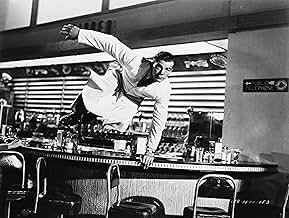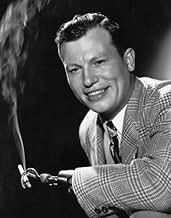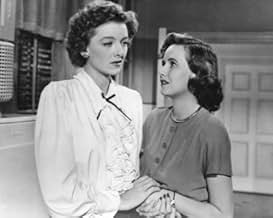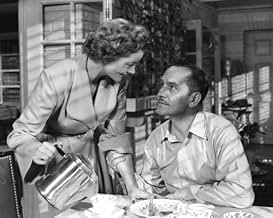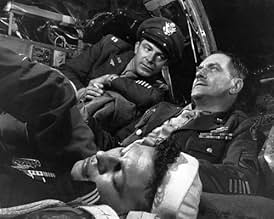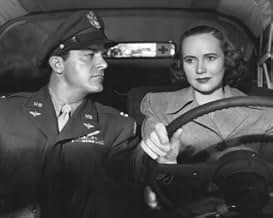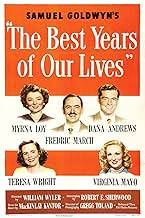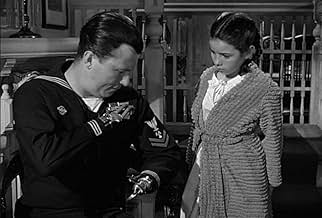Três veteranos da Segunda Guerra Mundial voltam para casa na cidade pequena da América para descobrir que eles e suas famílias foram mudados irreparavelmente.Três veteranos da Segunda Guerra Mundial voltam para casa na cidade pequena da América para descobrir que eles e suas famílias foram mudados irreparavelmente.Três veteranos da Segunda Guerra Mundial voltam para casa na cidade pequena da América para descobrir que eles e suas famílias foram mudados irreparavelmente.
- Ganhou 7 Oscars
- 21 vitórias e 3 indicações no total
- Al Stephenson
- (as Frederic March)
- Direção
- Roteiristas
- Elenco e equipe completos
- Produção, bilheteria e muito mais no IMDbPro
Best Picture Winners by Year
Best Picture Winners by Year
Enredo
Você sabia?
- CuriosidadesFor his performance as Homer Parrish, Harold Russell became the only actor to win two Academy Awards for the same role. The Academy Board of Governors thought he was a long shot to win, so they gave him an honorary award "for bringing hope and courage to his fellow veterans through his appearance." Later in the ceremony, he won for Best Supporting Actor.
- Erros de gravaçãoWhen Al introduces his wife and daughter to Fred and Homer at Butch's, he refers to Dana Andrews as Homer and Harold Russell as Fred. This was intended as a consequence of Al being drunk.
- Citações
[after Peggy tells her parents that they never had any trouble in their relationship]
Milly Stephenson: "We never had any trouble." How many times have I told you I hated you and believed it in my heart? How many times have you said you were sick and tired of me; that we were all washed up? How many times have we had to fall in love all over again?
- Cenas durante ou pós-créditosThe character played by Ray Teal (the Axis sympathizer whom Homer Parrish attacks at the soda fountain) is listed in the credits as "Mr. Mollett". However, the character's name is never mentioned or otherwise alluded to.
- Versões alternativasThe film was modified to play on a wide screen and reissued on February 3, 1954.
- ConexõesEdited into A Morte não é o Fim (1950)
- Trilhas sonorasAmong My Souvenirs
(1927) (uncredited)
Music by Edgar Leslie
Lyrics by Lawrence Wright
Played on piano by Hoagy Carmichael
The whole point of this film when it was released still makes perfect sense today, though I'm sure it doesn't have the same impact it did in those first years after World War II ended. Returning servicemen, with all kinds of backgrounds before and during the war, hit a wall coming home: wives who no longer loved them, jobs that had dried up, a culture that was foreign to them and that found them, these men, to be foreign themselves.
It wasn't a crisis to take lightly. These were the guys who were drafted to fight the enemy, and in going overseas they lost some of the best years of their lives, if not their lives. The country knew its debt in the abstract, but it also knew it in sons and husbands who really did come home and who had to face it all. This movie was both a reckoning for the sake of national healing and a brilliant drama that would be beautifully pertinent and therefore successful. And what a success, then and now.
The consummate Hollywood director William Wyler shows in this fast, long movie just what a master he is at working the medium. With Gregg Toland at the camera, Wyler makes a highly fluid movie, visual and dramatic and weirdly highly efficient. With the three main plots interweaving and depending on each other, the drama (and melodrama) build but never beyond plausibility. Wyler knew his audience wouldn't put up with pandering or cheap mistakes. Casting Harold Russell as Homer, knowing the audience would hear about how Russell really was a soldier who lost both hands in the war, was a huge step toward creating both empathy and credibility. It even practices a key theme in the move--to go beyond your bounds to make a difference, to give these guys a break and help them assimilate.
It's interesting how singular this movie is, trying to show the truth in these kinds of situations. The other post-war films about army and navy men fall into two large and dominating categories--war films and film noir. And it is film noir that comes closest to getting at the problem of the G.I. not reintegrating well, making it a whole style, brooding and spilling over with violence. "The Best Years of Our Lives" has a highly controlled and even contrived plot structure, but it aims to be honest and representative.
That it's remarkable formally--the way it is shot and edited and acted, top to bottom--is not surprise, given the heights that Hollywood had reached by then, and given that Wyler is easily the slickest of them all, in the best sense. That the movie makes such beautiful sense and really works as a story, a moving and heartwarming story without undue sappiness, is a whole other kind of achievement. A terrific, rich, full-blooded, uncompromised movie.
- secondtake
- 3 de out. de 2010
- Link permanente
Principais escolhas
Detalhes
- Data de lançamento
- País de origem
- Idioma
- Também conhecido como
- Os Melhores Anos de Nossas Vidas
- Locações de filme
- Ontario International Airport - 2900 E. Airport Drive, Ontario, Califórnia, EUA(Airplane graveyard)
- Empresa de produção
- Consulte mais créditos da empresa na IMDbPro
Bilheteria
- Orçamento
- US$ 2.100.000 (estimativa)
- Faturamento bruto nos EUA e Canadá
- US$ 23.650.000
- Faturamento bruto mundial
- US$ 23.667.133
- Tempo de duração2 horas 50 minutos
- Cor
- Proporção
- 1.37 : 1
Contribua para esta página



